A Comparative Study of Different Quality Oil Shales Developed in the Middle Jurassic Shimengou Formation, Yuqia Area, Northern Qaidam Basin, China
Abstract
:1. Introduction
2. Geological Setting
3. Data and Methods
3.1. TOC Analysis and Rock-Eval Pyrolysis
3.2. Oil Yield and Proximate Analyses
3.3. GC-MS Analysis
3.4. Vitrinite Reflectance and Maceral Analysis
3.5. X-ray Powder Diffraction, Major, Trace, and Rare Earth Element Analysis
4. Results
4.1. Oil-Shale Quality and TOC Content
4.2. Lithological Characteristics
4.3. Mineralogical Composition
4.4. Vitrinite Reflectance (Ro) and Rock-Eval Pyrolysis Parameters
4.5. Hydrocarbons and Biomarkers
4.6. Trace Elements
4.7. Maceral Composition
5. Discussion
5.1. Characteristics of Organic Matter
5.1.1. Organic Matter Enrichment and Thermal Maturity
5.1.2. Organic Matter Type and Source
5.2. Preservation Conditions
5.2.1. Salinity
5.2.2. Redox Conditions
5.2.3. Paleoproductivity
5.3. Controlling Factors on Oil Shale Quality
5.4. Organic Matter Enrichment Model
5.4.1. Low-Quality Oil Shales
5.4.2. Medium-Quality Oil Shales
5.4.3. High-Quality Oil Shales
6. Conclusions
Author Contributions
Funding
Institutional Review Board Statement
Informed Consent Statement
Data Availability Statement
Conflicts of Interest
References
- Amer, M.W.; Alhesan, J.S.A.; Marshall, M.; Fei, Y.; Jackson, W.R.; Chaffee, A.L. Energy efficient method of supercritical extraction of oil from oil shale. Energy Convers. Manag. 2021, 252, 115108. [Google Scholar] [CrossRef]
- Taheri-Shakib, J.; Kantzas, A. A comprehensive review of microwave application on the oil shale: Prospects for shale oil production. Fuel 2021, 305, 121519. [Google Scholar] [CrossRef]
- Qian, J.L.; Yin, L. Oil Shale–Petroleum Alternative. China Petrochem. 2010, pp. 1–15. (In Chinese with English Abstract). Available online: https://www.sciencedirect.com/science/article/abs/pii/S0016236121026491 (accessed on 20 July 2021).
- Saeed, S.A.; Taura, U.; Al-Wahaibi, Y.; Al-Muntaser, A.A.; Yuan, C.; Varfolomeev, M.A.; Al-Bahry, S.; Joshi, S.; Djimasbe, R.; Suwaid, M.A.; et al. Hydrothermal conversion of oil shale: Synthetic oil generation and micro-scale pore structure change. Fuel 2022, 312, 122786. [Google Scholar] [CrossRef]
- Altun, N.E.; Hicyilmaz, C.; Hwang, J.Y.; Suat BaǦci, A.; Kök, M.V. Oil shales in the world and Turkey; reserves, current situation and future prospects: A review. Oil Shale 2006, 23, 211–227. [Google Scholar]
- Alstadt, K.N.; Katti, K.S.; Katti, D.R. Nanoscale Morphology of Kerogen and In Situ Nanomechanical Properties of Green River Oil Shale. J. Nanomech. Micromech. 2016, 6, 04015003. [Google Scholar] [CrossRef]
- Yu, F.; Sun, P.; Zhao, K.; Ma, L.; Tian, X. Experimental constraints on the evolution of organic matter in oil shales during heating: Implications for enhanced in situ oil recovery from oil shales. Fuel 2019, 261, 116412. [Google Scholar] [CrossRef]
- Ofili, S.; Soesoo, A. General geology and geochemistry of the Lokpanta Formation oil shale, Nigeria. Oil Shale 2021, 38, 1–25. [Google Scholar] [CrossRef]
- Sun, P.; Liu, Z.; Bai, Y.; Xu, Y.; Liu, R.; Meng, Q.; Hu, F. Accumulation stages and evolution characteristics of oil shale and coal in the Dunhua-Mishan Fault Zone, northeast China. Oil Shale 2016, 33, 203–215. [Google Scholar] [CrossRef] [Green Version]
- Xu, S.-C.; Liu, Z.-J.; Zhang, P.; Boak, J.M.; Liu, R.; Meng, Q.-T. Characterization of depositional conditions for lacustrine oil shales in the Eocene Jijuntun Formation, Fushun Basin, NE China. Int. J. Coal Geol. 2016, 167, 10–30. [Google Scholar] [CrossRef] [Green Version]
- Liu, Z.; Meng, Q.; Dong, Q.; Zhu, J.; Guo, W.; Ye, S.; Liu, R.; Jia, J. Characteristics and resource potential of oil shale in China. Oil Shale 2017, 34, 15–41. [Google Scholar] [CrossRef] [Green Version]
- Wang, L.; Zhao, Y.; Yang, D.; Kang, Z.; Zhao, J. Effect of pyrolysis on oil shale using superheated steam: A case study on the Fushun oil shale, China. Fuel 2019, 253, 1490–1498. [Google Scholar] [CrossRef]
- Xu, Y.; Sun, P.; Yao, S.; Liu, Z.; Tian, X.; Li, F.; Zhang, J. Progress in exploration. development and utilization of oil shale in China. Oil Shale 2019, 36, 285–304. [Google Scholar] [CrossRef] [Green Version]
- He, W.; Sun, Y.; Guo, W.; Shan, X. Controlling the in-situ conversion process of oil shale via geochemical methods: A case study on the Fuyu oil shale, China. Fuel Process. Technol. 2021, 219, 106876. [Google Scholar] [CrossRef]
- Zhang, P.; Meng, Q.; Misch, D.; Sachsenhofer, R.F.; Liu, Z.; Hu, F.; Shen, L. Oil shale potential of the lower cretaceous Jiufotang Formation, Beipiao Basin, Northeast China. Int. J. Coal Geol. 2020, 236, 103640. [Google Scholar] [CrossRef]
- Elik, Y.; Karayigit, A.I.; Oskay, R.G.; Kayseri-Özer, M.S.; Christanis, K.; Hower, J.C.; Querol, X. A multidisciplinary study and palaeoenvironmental interpretation of middle Miocene Keles lignite (Harmancık Basin, NW Turkey), with emphasis on syngenetic zeolite formation. Int. J. Coal Geol. 2021, 237, 1–33. [Google Scholar]
- Döner, Z.; Hu, Q.; Kumral, M.; Kibria, G.; Qiao, H.; Sun, M. Petrophysical Characteristics of Silurian Mudstones from Central Taurides in Southern Turkey. J. Earth Sci. 2021, 32, 778–798. [Google Scholar] [CrossRef]
- Song, Y.; Zhu, K.; Xu, Y.; Meng, Q.; Liu, Z.; Sun, P.; Ye, X. Paleovegetational Reconstruction and Implications on Formation of Oil Shale and Coal in the Lower Cretaceous Laoheishan Basin (NE China): Evidence from Palynology and Terpenoid Biomarkers. Energies 2021, 14, 4704. [Google Scholar] [CrossRef]
- Ellis, R. Oil Shale: A Fuel Lifeline; Publisher Mining Journal Ltd.: London, UK, 2009; pp. 1–10. [Google Scholar]
- Knaus, E.; Killen, J.; Biglarbigi, K.; Crawford, P. An overview of oil shale resources. Oil Shale: A Solution to the Liquid Fuel Dilemma. ACS Symp. Ser. 2010, 1032, 3–20. [Google Scholar]
- Valgma, I.; Reinsalu, E.; Sabanov, S.; Karu, V. Quality control of oil shale production in Estonian mines. Oil Shale 2010, 27, 239–249. [Google Scholar] [CrossRef] [Green Version]
- Zhu, G.; Zhang, B.; Zhao, P.; Duan, C.; Zhao, Y.; Zhang, Z.; Yan, G.; Zhu, X.; Ding, W.; Rao, Z. Upgrading low-quality oil shale using high-density gas-solid fluidized bed. Fuel 2019, 252, 666–674. [Google Scholar] [CrossRef]
- Meng, Q.; Liu, Z.; Sun, P.; Xu, Y.; Li, F.; Bai, Y.; Xie, W.; Deng, S.; Song, S.; Wang, K.; et al. Characteristics and accumulation of Middle Jurassic oil shale in the Yuqia area, northern Qaidam Basin, northwest China. Oil Shale 2018, 35, 1–25. [Google Scholar] [CrossRef]
- Bai, Y.; Lv, Q.; Liu, Z.; Sun, P.; Xu, Y.; Meng, J.; Meng, Q.; Xie, W.; Wang, J.; Wang, K. Major, trace and rare earth element geochemistry of coal and oil shale in the Yuqia area, Middle Jurassic Shimengou Formation, northern Qaidam Basin. Oil Shale 2020, 37, 1–31. [Google Scholar] [CrossRef]
- Guo, W.; Chen, G.; Li, Y.; Li, Y.; Zhang, Y.; Zhou, J.; Han, W.; Xu, X.; Ma, Y.; Dang, H. Factors Controlling the Lower Radioactivity and Its Relation with Higher Organic Matter Content for Middle Jurassic Oil Shale in Yuqia Depression, Northern Qaidam Basin, China: Evidence from Organic and Inorganic Geochemistry. ACS Omega 2021, 6, 7360–7373. [Google Scholar] [CrossRef]
- Wang, Y.; Xu, S.; Hao, F.; Poulton, S.W.; Zhang, Y.; Guo, T.; Lu, Y.; Bai, N. Arid climate disturbance and the development of salinized lacustrine oil shale in the Middle Jurassic Dameigou Formation, Qaidam Basin, northwestern China. Palaeogeogr. Palaeoclim. Palaeoecol. 2021, 577, 110533. [Google Scholar] [CrossRef]
- Xie, W.; Tan, J.; Wang, W.; Schulz, H.-M.; Liu, Z.; Kang, X.; Wang, Y.; Shahzad, A.; Jan, I.U. Middle Jurassic lacustrine source rocks controlled by an aridification event: A case study in the northern Qaidam Basin (NW China). Int. J. Coal Geol. 2021, 242, 103779. [Google Scholar] [CrossRef]
- Wang, J.X.; Liu, Z.J.; Sun, P.C.; Bai, Y.Y.; Deng, S. Types and mineralizing differences for Middle Jurassic oil shale in Yuqia region of North margin in Qaidam Basin. Pet. Geol. Oilfield Dev. Daqing 2017, 4, 168–174, (In Chinese with English Abstract). [Google Scholar]
- Li, M.; Shao, L.; Lu, J.; Spiro, B.; Wen, H.; Li, Y. Sequence stratigraphy and paleogeography of the Middle Jurassic coal measures in the Yuqia coalfield, northern Qaidam Basin, northwestern China. AAPG Bull. 2014, 98, 2531–2550. [Google Scholar] [CrossRef]
- Wang, X.; Li, Y.; Zhang, Y.; Li, Z.; Guo, W.; Song, B. An analysis of reservoir-forming conditions of shale gas in Middle Jurassic strata of Yuqia area, Qaidam Basin. Geol. Bull. China 2016, 35, 231–241. [Google Scholar]
- Hou, H.; Shao, L.; Li, Y.; Li, Z.; Wang, S.; Zhang, W.; Wang, X. Influence of coal petrology on methane adsorption capacity of the Middle Jurassic coal in the Yuqia Coalfield, northern Qaidam Basin, China. J. Pet. Sci. Eng. 2017, 149, 218–227. [Google Scholar] [CrossRef]
- Hou, H.; Shao, L.; Li, Y.; Li, Z.; Zhang, W.; Wen, H. The pore structure and fractal characteristics of shales with low thermal maturity from the Yuqia Coalfield, northern Qaidam Basin, northwestern China. Front. Earth Sci. 2018, 12, 148–159. [Google Scholar] [CrossRef]
- GB/T 19145–2003; National Standard of the People’s Republic of China. Determination of Total Organic Carbon in Sedimentary Rock. General Administration of Quality Supervision, Inspection and Quarantine of the People’s Republic of China: Beijing, China, 2003; (In Chinese with English Abstract).
- Behar, F.; Beaumont, V.; Penteado, H.D.B. Rock-Eval 6 technology: Performances and developments. Oil Gas Sci. Technol. 2001, 56, 111–134. [Google Scholar] [CrossRef]
- LaFargue, E.; Marquis, F.; Pillot, D. Rock-Eval 6 Applications in Hydrocarbon Exploration, Production, and Soil Contamination Studies. Rev. Inst. Fr. Pétrole 1998, 53, 421–437. [Google Scholar] [CrossRef] [Green Version]
- SH/T 0508-92; Petrochemical Industry Standard of the People’s Republic of China. The Measuring Method of Oil Yield from Oil Shale—Low Temperature Carbonization. China Petrochemical Corporation: Beijing, China, 1992; (In Chinese with English Abstract).
- GB/T 213–2008; National Standard of the People’s Republic of China. Determination of Calorific Value of Coal. General Administration of Quality Supervision, Inspection and Quarantine of the People’s Republic of China: Beijing, China, 2008; (In Chinese with English Abstract).
- GB/T 212–2008; National Standard of the People’s Republic of China. Proximate Analysis of Coal. General Administration of Quality Supervision, Inspection and Quarantine of the People’s Republic of China: Beijing, China, 2008; (In Chinese with English Abstract).
- Ahmed, M.; George, S. Changes in the molecular composition of crude oils during their preparation for GC and GC–MS analyses. Org. Geochem. 2004, 35, 137–155. [Google Scholar] [CrossRef]
- Luo, Q.; George, S.; Xu, Y.; Zhong, N. Organic geochemical characteristics of the Mesoproterozoic Hongshuizhuang Formation from northern China: Implications for thermal maturity and biological sources. Org. Geochem. 2016, 99, 23–37. [Google Scholar] [CrossRef]
- SY/T 5124–2012; Petroleum and Natural Gas Industry Standard of the People’s Republic of China. Method of Determining Microscopically the Reflectance of Vitrinite in Sedimentary. National Energy Administration: Beijing, China, 2012; (In Chinese with English Abstract).
- Pickel, W.; Kus, J.; Flores, D.; Kalaitzidis, S.; Christanis, K.; Cardott, B.J.; Misz-Kennan, M.; Rodrigues, S.; Hentschel, A.; Hamor-Vido, M.; et al. Classification of liptinite–ICCP system 1994. Int. J. Coal Geol. 2017, 169, 40–61. [Google Scholar] [CrossRef] [Green Version]
- ICCP. The new vitrinite classification (ICCP system 1994). Fuel 1998, 77, 349–358. [Google Scholar] [CrossRef]
- ICCP. The new inertinite classification (ICCP system 1994). Fuel 2001, 80, 459–471. [Google Scholar] [CrossRef]
- Taylor, H.; Teichmüller, M.; Davis, A.; Diessel, C.F.K.; Littke, R.; Robert, P. Organic Petrology; Borntraeger: Stuttgart, Germany, 1998; pp. 15–169. [Google Scholar]
- Liu, B.; Bechtel, A.; Sachsenhofer, R.; Gross, D.; Gratzer, R.; Chen, X. Depositional environment of oil shale within the second member of Permian Lucaogou Formation in the Santanghu Basin, Northwest China. Int. J. Coal Geol. 2017, 175, 10–25. [Google Scholar] [CrossRef]
- SY/T 6210–2010; Petroleum and Natural Gas Industry Standard of the People’s Republic of China. Quantitative Analysis of Total Contents of Clay Minerals and Common Non-Clay Minerals in Sedimentary Rocks by X-ray Diffraction. National Energy Administration: Beijing, China, 2010; (In Chinese with English Abstract).
- GB/T 14506.30–2010; National Standard of the People’s Republic of China. Methods for Chemical Analysis of Silicate Rocks-Part 30: Determination of 44 Elements. General Administration of Quality Supervision, Inspection and Quarantine of the People’s Republic of China: Beijing, China, 2010; (In Chinese with English Abstract).
- Kimura, T. Relationships between inorganic elements and minerals in coals from the Ashibetsu district, Ishikari coal field, Japan. Fuel Process. Technol. 1998, 56, 1–19. [Google Scholar] [CrossRef]
- Dai, S.; Liu, J.; Ward, C.; Hower, J.C.; Xie, P.; Jiang, Y.; Hood, M.M.; O’Keefe, J.M.; Song, H. Petrological, geochemical, and mineralogical compositions of the low-Ge coals from the Shengli Coalfield, China: A comparative study with Ge-rich coals and a formation model for coal-hosted Ge ore deposit. Ore Geol. Rev. 2015, 71, 318–349. [Google Scholar] [CrossRef]
- Liu, Y.T.; Yang, S.Y.; Hu, K.; Cao, J.; Bian, L.Z.; Wang, L.Q.; Chan, Y. Organic geochemical features and its hydrocarbon generation potential of mudstone source rock from 7th Member of Middle Jurassic in the northern margin of Qaidam Basin. Geol. J. China Univ. 2007, 4, 703–713, (In Chinese with English Abstract). [Google Scholar]
- Chen, L. The Study of Sedimentary Characteristics and Accumulation of Iqe Coalfield in Qinghai Province. Master’s Thesis, Xi’an University of Science and Technology, Xi’an, China, 2013; pp. 20–80, (In Chinese with English Abstract). [Google Scholar]
- Ma, X.M.; Hao, H.Y.; Ma, F.; Duan, G.L.; Cheng, Y.H. Developmental value of oil shale in the 7th Member of Middle Jurassic in Yuqia Area, Qaidam Basin. J. Southwest Pet. Univ. Sci. Technol. Ed. 2013, 3, 52–58, (In Chinese with English Abstract). [Google Scholar]
- Boynton, W.V. Cosmochemistry of the rare earth elements. In Rare Earth Elements Geochemistry: Developments in Geochemistry; Henderson, P., Ed.; Elsevier: Amsterdam, The Netherlands, 1984; pp. 63–114. [Google Scholar]
- Jia, J.L. Research on the Recognition and Resource Evaluation of the Upper Cretaceous Oil Shale Based on Geochemistry-Geophysics Technique in the Songliao Basin (NE, China). Ph.D. Thesis, Jilin University, Jilin, China, 2012; pp. 53–126, (In Chinese with English Abstract). [Google Scholar]
- Mani, D.; Kalpana, M.S.; Patil, D.J.; Dayal, A.M. Chapter 3—Organic matter in gas shales: Origin, evolution, and characterization. Shale Gas 2017, 25–54. [Google Scholar] [CrossRef]
- Wilkins, R.W.; Wilmshurst, J.R.; Russell, N.J.; Hladky, G.; Ellacott, M.V.; Buckingham, C. Fluorescence alteration and the suppression of vitrinite reflectance. Org. Geochem. 1992, 18, 629–640. [Google Scholar] [CrossRef]
- Peters, K.E.; Walters, C.C.; Moldowan, J.M. The Biomarker Guide, Biomarkers and Isotopes in Petroleum Exploration and Earth History; Cambridge University Press: New York, NY, USA, 2005; pp. 1–256. [Google Scholar]
- Nazir, A.; Fazeelat, T. Geochemistry of cretaceous rocks, Pakistan: I. Biomarker approach to assess thermal maturity of OM. Pet. Sci. Technol. 2017, 35, 875–882. [Google Scholar] [CrossRef]
- Agrawal, V.; Sharma, S. Molecular characterization of kerogen and its implications for determining hydrocarbon potential, organic matter sources and thermal maturity in Marcellus Shale. Fuel 2018, 228, 429–437. [Google Scholar] [CrossRef]
- Patra, S.; Dirghangi, S.S.; Rudra, A.; Dutta, S.; Ghosh, S.; Varma, A.K.; Shome, D.; Kalpana, M. Effects of thermal maturity on biomarker distributions in Gondwana coals from the Satpura and Damodar Valley Basins, India. Int. J. Coal Geol. 2018, 196, 63–81. [Google Scholar] [CrossRef]
- Shalaby, M.R.; Osli, L.N.; Kalaitzidis, S.; Islam, A. Thermal maturity and depositional palaeoenvironments of the Cretaceous-Palaeocene source rock Taratu Formation, Great South Basin, New Zealand. J. Pet. Sci. Eng. 2019, 181, 106156. [Google Scholar] [CrossRef]
- Yi, L.; Liu, Z.; Chen, Z.; Li, M. Thermal maturity, source characteristics, and migration directions for the Ordovician oil in the Central Tabei Uplift, Tarim Basin: Insight from biomarker geochemistry. J. Pet. Sci. Eng. 2020, 189, 106975. [Google Scholar] [CrossRef]
- Espitalié, J.; Marquis, F.; Barsony, I. Geochemical logging. In Anal Pyrol; Voorhess, K.J., Ed.; Butterworths: Boston, MA, USA, 1984; pp. 53–79. [Google Scholar]
- Langford, F.F.; Blanc-Valleron, M.M. Interpreting Rock-Eval pyrolysis data using graphs of pyrolyzable hydrocarbons vs. total organic carbon. AAPG Bull. 1990, 74, 799–804. [Google Scholar]
- Mukhopadhyay, P.K.; Wade, J.A.; Kruge, M.A. Organic facies and maturation of Jurassic/Cretaceous rocks, and possible oil-source rock correlation based on pyrolysis of asphaltenes, Scotian Basin, Canada. Org. Geochem. 1995, 22, 85–104. [Google Scholar] [CrossRef]
- Tissot, B.P.; Welte, D.H. Petroleum Formation and Occurrence; Springer: New York, NY, USA, 1984. [Google Scholar]
- Qin, J.; Wang, S.; Sanei, H.; Jiang, C.; Chen, Z.; Ren, S.; Xu, X.; Yang, J.; Zhong, N. Revelation of organic matter sources and sedimentary environment characteristics for shale gas formation by petrographic analysis of middle Jurassic Dameigou formation, northern Qaidam Basin, China. Int. J. Coal Geol. 2018, 195, 373–385. [Google Scholar] [CrossRef]
- Cavelan, A.; Boussafir, M.; Le Milbeau, C.; Rozenbaum, O.; Laggoun-Défarge, F. Effect of organic matter composition on source rock porosity during confined anhydrous thermal maturation: Example of Kimmeridge-clay mudstones. Int. J. Coal Geol. 2019, 212, 103236. [Google Scholar] [CrossRef] [Green Version]
- Khan, I.; Zhong, N.; Luo, Q.; Ai, J.; Yao, L.; Luo, P. Maceral composition and origin of organic matter input in Neoproterozoic–Lower Cambrian organic-rich shales of Salt Range Formation, upper Indus Basin, Pakistan. Int. J. Coal Geol. 2020, 217, 103319. [Google Scholar] [CrossRef]
- Hu, G.; Pang, Q.; Jiao, K.; Hu, C.; Liao, Z. Development of organic pores in the Longmaxi Formation overmature shales: Combined effects of thermal maturity and organic matter composition. Mar. Pet. Geol. 2020, 116, 104314. [Google Scholar] [CrossRef]
- Cao, J.; Wu, M.; Chen, Y.; Hu, K.; Bian, L.; Wang, L.; Zhang, Y. Trace and rare earth element geochemistry of Jurassic mudstones in the northern Qaidam Basin, northwest China. Geochemistry 2012, 72, 245–252. [Google Scholar] [CrossRef]
- Jiang, K.; Lin, C.; Zhang, X.; Cai, C.; Xiao, F.; He, W.; Peng, L. Variations in abundance and distribution of methyltrimethyltridecylchromans (MTTCs) in sediments from saline lacustrine settings in Cenozoic lacustrine basins, China. Org. Geochem. 2018, 121, 58–67. [Google Scholar] [CrossRef]
- Martins, L.L.; Schulz, H.-M.; Ribeiro, H.J.P.S.; Nascimento, C.A.D.; de Souza, E.S.; da Cruz, G.F. Organic geochemical signals of freshwater dynamics controlling salinity stratification in organic-rich shales in the Lower Permian Irati Formation (Paraná Basin, Brazil). Org. Geochem. 2020, 140, 103958. [Google Scholar] [CrossRef]
- Said, I.; Merz, C.; Salman, S.A.E.-R.; Schneider, M.; Winkler, A. Identification of hydrochemical processes using multivariate statistics in a complex aquifer system of Sohag region, Egypt. Environ. Earth Sci. 2020, 79, 1–14. [Google Scholar] [CrossRef]
- Yin, J.; Xu, C.; Hao, F.; Wang, Q.; Miao, Q.; Wang, Z.; Zou, H. Controls on organic matter enrichment in source rocks of the Shahejie Formation in the southwestern Bozhong Sag, Bohai Bay Basin, China. Palaeogeogr. Palaeoclim. Palaeoecol. 2020, 560, 110026. [Google Scholar] [CrossRef]
- Argiriadis, E.; Bortolini, M.; Kehrwald, N.M.; Roman, M.; Turetta, C.; Hanif, S.; Erhenhi, E.O.; Aliaga, J.M.R.; McWethy, D.B.; Myrbo, A.E.; et al. Rapa Nui (Easter Island) Rano Raraku crater lake basin: Geochemical characterization and implications for the Ahu-Moai Period. PLoS ONE 2021, 16, e0254793. [Google Scholar] [CrossRef]
- Kocsis, L.; Gheerbrant, E.; Mouflih, M.; Cappetta, H.; Ulianov, A.; Chiaradia, M.; Bardet, N. Gradual changes in upwelled seawater conditions (redox, pH) from the late Cretaceous through early Paleogene at the northwest coast of Africa: Negative Ce anomaly trend recorded in fossil bio-apatite. Chem. Geol. 2016, 421, 44–54. [Google Scholar] [CrossRef]
- Tostevin, R.; Shields, G.A.; Tarbuck, G.M.; He, T.; Clarkson, M.; Wood, R.A. Effective use of cerium anomalies as a redox proxy in carbonate-dominated marine settings. Chem. Geol. 2016, 438, 146–162. [Google Scholar] [CrossRef] [Green Version]
- Chen, X.; Wei, K.; Zhang, B.M.; Li, P.; Li, H.; Liu, A.; Luo, S. Main geological factors controlling shale gas reservior in the Cambrian Shuijingtuo Formation in Yichang of Hubei Province as well as its and enrichment patterns. Geol. China 2018, 45, 207–226. [Google Scholar]
- Ocubalidet, S.G.; Rimmer, S.M.; Conder, J.A. Redox conditions associated with organic carbon accumulation in the Late Devonian New Albany Shale, west-central Kentucky, Illinois Basin. Int. J. Coal Geol. 2018, 190, 42–55. [Google Scholar] [CrossRef]
- Nguyen, K.; Love, G.D.; Zumberge, J.A.; Kelly, A.E.; Owens, J.D.; Rohrssen, M.K.; Bates, S.M.; Cai, C.; Lyons, T.W. Absence of biomarker evidence for early eukaryotic life from the Mesoproterozoic Roper Group: Searching across a marine redox gradient in mid-Proterozoic habitability. Geobiology 2019, 17, 247–260. [Google Scholar] [CrossRef]
- Zindorf, M.; Rush, D.; Jaeger, J.; Mix, A.; Penkrot, M.L.; Schnetger, B.; Sidgwick, F.R.; Talbot, H.M.; van der Land, C.; Wagner, T.; et al. Reconstructing oxygen deficiency in the glacial Gulf of Alaska: Combining biomarkers and trace metals as paleo-redox proxies. Chem. Geol. 2020, 558, 119864. [Google Scholar] [CrossRef]
- Song, Y.; Gilleaudeau, G.J.; Algeo, T.J.; Over, D.J.; Lyons, T.W.; Anbar, A.D.; Xie, S. Biomarker evidence of algal-microbial community changes linked to redox and salinity variation, Upper Devonian Chattanooga Shale (Tennessee, USA). GSA Bull. 2020, 133, 409–424. [Google Scholar] [CrossRef]
- Lopes, F.; Kochhann, K.G.D.; Norris, R.D.; Savian, J.F.; Fauth, G. Export Primary Productivity Changes in the Maud Rise (Weddell Sea) during the Maastrichtian. In AGU Fall Meeting Abstracts; AGU: San Francisco, CA, USA, 2019; p. PP13C-1479. [Google Scholar]
- Wang, Y.; Xu, S.; Hao, F.; Lu, Y.; Shu, Z.; Yan, D.; Lu, Y. Geochemical and petrographic characteristics of Wufeng-Longmaxi shales, Jiaoshiba area, southwest China: Implications for organic matter differential accumulation. Mar. Pet. Geol. 2018, 102, 138–154. [Google Scholar] [CrossRef]
- Zeng, S.; Wang, J.; Chen, W.; Fu, X.; Feng, X.; Song, C.; Wang, D.; Sun, W. Geochemical characteristics of Early Cretaceous marine oil shale from the Changshe Mountain area in the northern Qiangtang Basin, Tibet: Implications for palaeoweathering, provenance, tectonic setting, and organic matter accumulation. Geol. J. 2020, 55, 3229–3246. [Google Scholar] [CrossRef]
- Zhang, T.; Sun, S.; Li, Y.; Zong, W.; Sun, Q. Primary productivity and basin redox conditions within the Mesoproterozoic Hongshuizhuang Formation from Chaoyang area, Liaoxi sag. In IOP Conference Series: Earth and Environmental Science; IOP Publishing: Bristol, UK, 2020; Volume 600, p. 012052. [Google Scholar]
- Song, L.; Qiang, M.; Lang, L.; Liu, X.; Wang, Q.; Li, M. Changes in palaeoproductivity of Genggahai Lake over the past 16 ka in the Gonghe Basin, northeastern Qinghai-Tibetan Plateau. Chin. Sci. Bull. 2012, 57, 2595–2605. [Google Scholar] [CrossRef] [Green Version]
- Bao, Q.; Liu, Z.; Zhao, M.; Hu, Y.; Li, D.; Han, C.; Wei, Y.; Ma, S.; Zhang, Y. Primary productivity and seasonal dynamics of planktonic algae species composition in karst surface waters under different land uses. J. Hydrol. 2020, 591, 125295. [Google Scholar] [CrossRef]
- Guo, W.; Gong, D.; Qiao, Q. Research progress and ideas of Influence of hydrological regimes on river primary productivity of algae. In IOP Conference Series: Earth and Environmental Science; IOP Publishing: Bristol, UK, 2020; Volume 558, p. 42013. [Google Scholar]
- He, J.; Ding, W.; Jiang, Z.; Jiu, K.; Li, A.; Sun, Y. Mineralogical and chemical distribution of the Es3L oil shale in the Jiyang Depression, Bohai Bay Basin (E China): Implications for paleoenvironmental reconstruction and organic matter accumulation. Mar. Pet. Geol. 2017, 81, 196–219. [Google Scholar] [CrossRef]
- Chen, G.; Gang, W.; Liu, Y.; Wang, N.; Guo, Y.; Zhu, C.; Cao, Q. High-resolution sediment accumulation rate determined by cyclostratigraphy and its impact on the organic matter abundance of the hydrocarbon source rock in the Yanchang Formation, Ordos Basin, China. Mar. Pet. Geol. 2019, 103, 1–11. [Google Scholar] [CrossRef]
- Theng, B.K.G. Formation and Properties of Clay-Polymer Complexes; Elsevier: Kidlington, UK, 2012; Volume 4, pp. 1–50. [Google Scholar]
- Kuila, U.; McCarty, D.K.; Derkowski, A.; Fischer, T.B.; Topór, T.; Prasad, M. Nano-scale texture and porosity of organic matter and clay minerals in organic-rich mudrocks. Fuel 2014, 135, 359–373. [Google Scholar] [CrossRef] [Green Version]
- Katz, B.J. Limitations of ‘Rock-Eval’ pyrolysis for typing organic matter. Org. Geochem. 1983, 4, 195–199. [Google Scholar] [CrossRef]
- Spiro, B. Effects of minerals on Rock Eval pyrolysis of kerogen. J. Therm. Anal. 1991, 37, 1513–1522. [Google Scholar] [CrossRef]
- Yang, S.; Horsfield, B. Critical review of the uncertainty of Tmax in revealing the thermal maturity of organic matter in sedimentary rocks. Int. J. Coal Geol. 2020, 225, 103500. [Google Scholar] [CrossRef]
- Karayigit, A.I.; Oskay, R.G.; Çelik, Y. Mineralogy, petrography, and Rock-Eval pyrolysis of late Oligocene coal seams in the Malkara coal field from the Thrace Basin (NW Turkey). Int. J. Coal Geol. 2021, 244, 103814. [Google Scholar] [CrossRef]
- Li, W.; Lu, S.; Tan, Z.; He, T. Lacustrine Source Rock Deposition in Response to Coevolution of the Paleoenvironment and Formation Mechanism of Organic-Rich Shales in the Biyang Depression, Nanxiang Basin. Energy Fuels 2017, 31, 13519–13527. [Google Scholar] [CrossRef]
- Chen, Z.; Cui, J.; Ren, Z.; Jiang, S.; Liang, X.; Wang, G.; Zou, C. Geochemistry, Paleoenvironment and Mechanism of Organic-Matter Enrichment in the Lower Silurian Longmaxi Formation Shale in the Sichuan Basin, China. Acta Geol. Sin. Engl. Ed. 2019, 93, 505–519. [Google Scholar] [CrossRef]
- Bueno, C.; Figueira, R.C.L.; Ivanoff, M.D.; Toldo, E.E.; Ferreira, P.A.L.; Fornaro, L.; García-Rodríguez, F. Inferring centennial terrigenous input for Patos Lagoon, Brazil: The world’s largest choked coastal lagoon. J. Paleolimnol. 2021, 66, 157–169. [Google Scholar] [CrossRef]
- Liu, C.; Wang, P. The role of algal blooms in the formation of lacustrine petroleum source rocks-Evidence from Jiyang depression, Bohai Gulf Rift Basin, eastern China. Palaeogeogr. Palaeoclimatol. Palaeoecol. 2013, 388, 15–22. [Google Scholar] [CrossRef]
- Hu, Y.; Liu, C.-Y.; Yang, G.-P.; Zhang, H.-H. The response of the carbonate system to a green algal bloom during the post-bloom period in the southern Yellow Sea. Cont. Shelf Res. 2015, 94, 1–7. [Google Scholar] [CrossRef]
- Huh, J.-H.; Choi, Y.-H.; Lee, H.-J.; Choi, W.J.; Ramakrishna, C.; Lee, H.-W.; Lee, S.-H.; Ahn, J.-W. The Use of Oyster Shell Powders for Water Quality Improvement of Lakes by Algal Blooms Removal. J. Korean Ceram. Soc. 2016, 53, 1–6. [Google Scholar] [CrossRef] [Green Version]
- Bates, A.L.; Spiker, E.C.; Orem, W.H.; Burnett, W.C. Speciation and isotopic composition of sulfur in sediments from Jellyfish Lake, Palau. Chem. Geol. 1993, 106, 63–76. [Google Scholar] [CrossRef]
- Larsen, C.; MacDonald, G. Lake morphometry, sediment mixing and the selection of sites for fine resolution palaeoecological studies. Quat. Sci. Rev. 1993, 12, 781–792. [Google Scholar] [CrossRef]
- Gingras, M.K.; MacEachern, J.A.; Dashtgard, S.E. The potential of trace fossils as tidal indicators in bays and estuaries. Sediment. Geol. 2012, 279, 97–106. [Google Scholar] [CrossRef]
- Wang, X.; Jin, Z.; Zhao, J.; Zhu, Y.; Hu, Z.; Liu, G.; Jiang, T.; Wang, H.; Li, S.; Shi, S. Depositional environment and organic matter accumulation of Lower Jurassic nonmarine fine-grained deposits in the Yuanba Area, Sichuan Basin, SW China. Mar. Pet. Geol. 2020, 116, 104352. [Google Scholar] [CrossRef]
- Mort, H.P.; Adatte, T.; Föllmi, K.B.; Keller, G.; Steinmann, P.; Matera, V.; Berner, Z.A.; Stüben, D. Phosphorus and the roles of productivity and nutrient recycling during oceanic anoxic event 2. Geology 2007, 35, 483. [Google Scholar] [CrossRef]
- Hakimi, M.H.; Abdullah, W.H.; Alqudah, M.; Makeen, Y.M.; Mustapha, K.A. Organic geochemical and petrographic characteristics of the oil shales in the Lajjun area, Central Jordan: Origin of organic matter input and preservation conditions. Fuel 2016, 181, 34–45. [Google Scholar] [CrossRef]
- Torelli, M.; Battani, A.; Pillot, D.; Kohler, E.; De Azevedo, J.L.; Kowalewski, I.; Pastor, L.; Brandily, C.; Schmidt, S.; Jouet, G.; et al. Origin and preservation conditions of organic matter in the Mozambique Channel: Evidence for widespread oxidation processes in the deep-water domains. Mar. Geol. 2021, 440, 106589. [Google Scholar] [CrossRef]
- Maynard, J.B. Extension of Berner’s “New geochemical classification of sedimentary environments” to ancient sediments. J. Sediment. Res. 1982, 52, 1325–1331. [Google Scholar] [CrossRef]

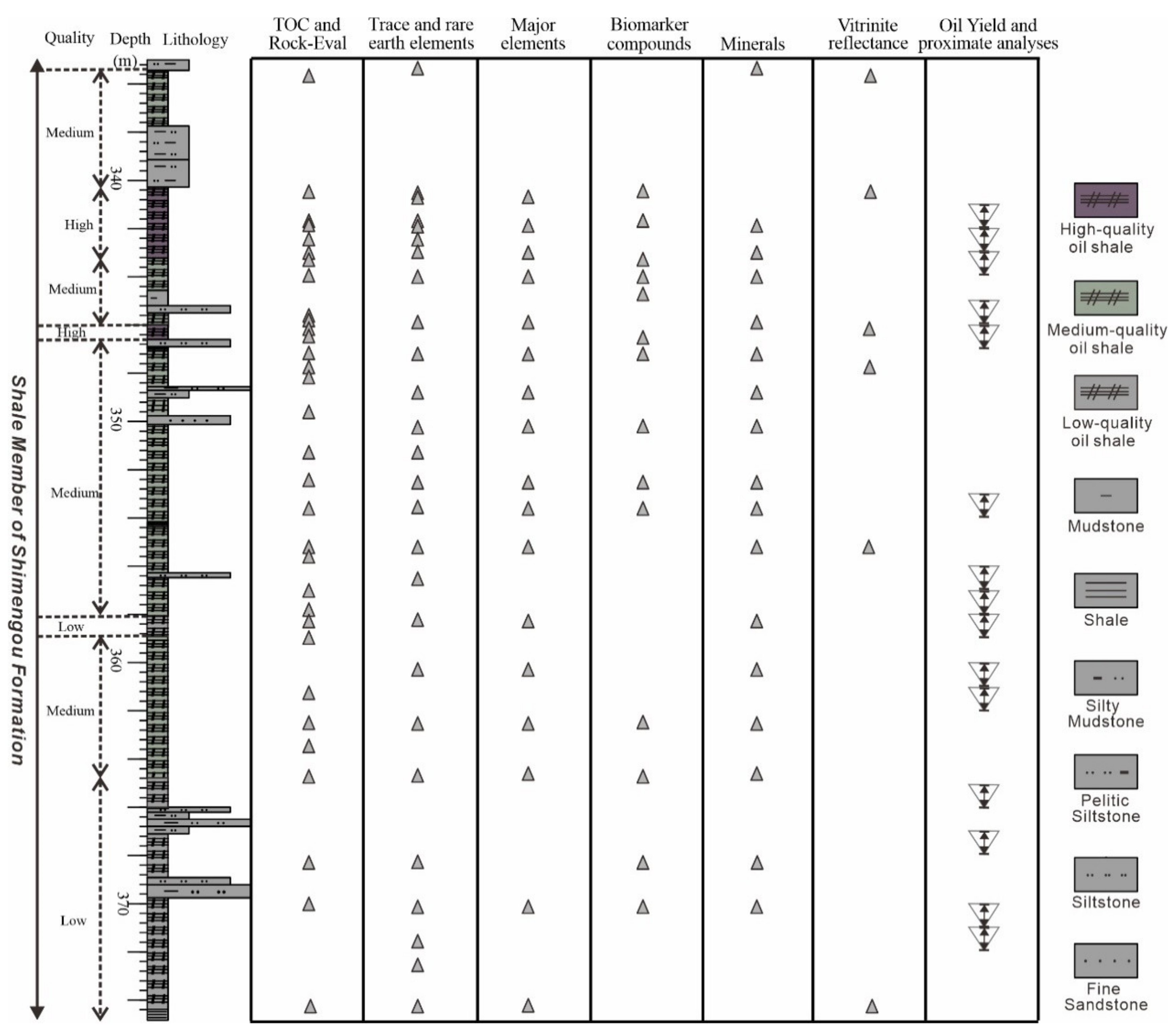
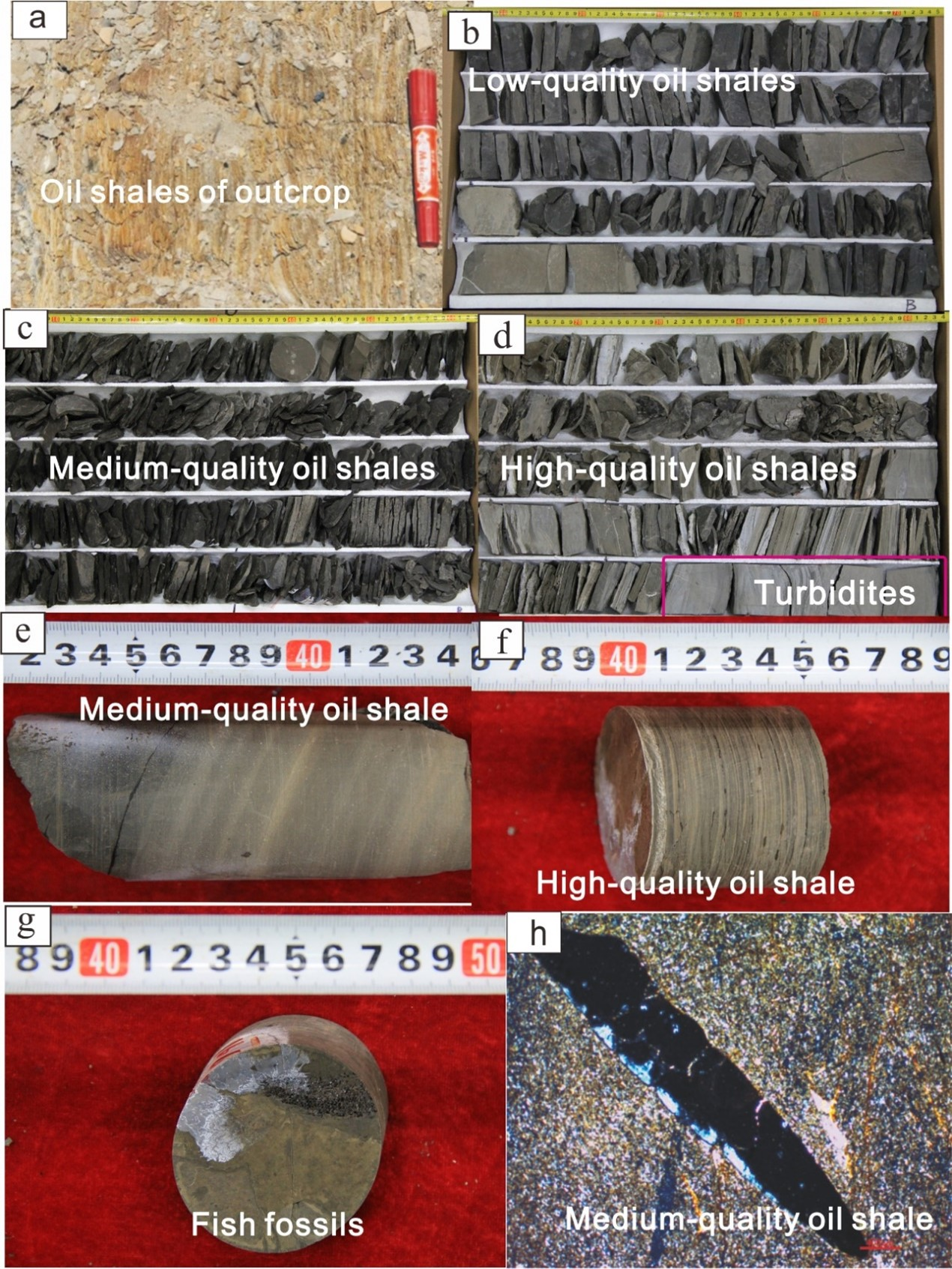
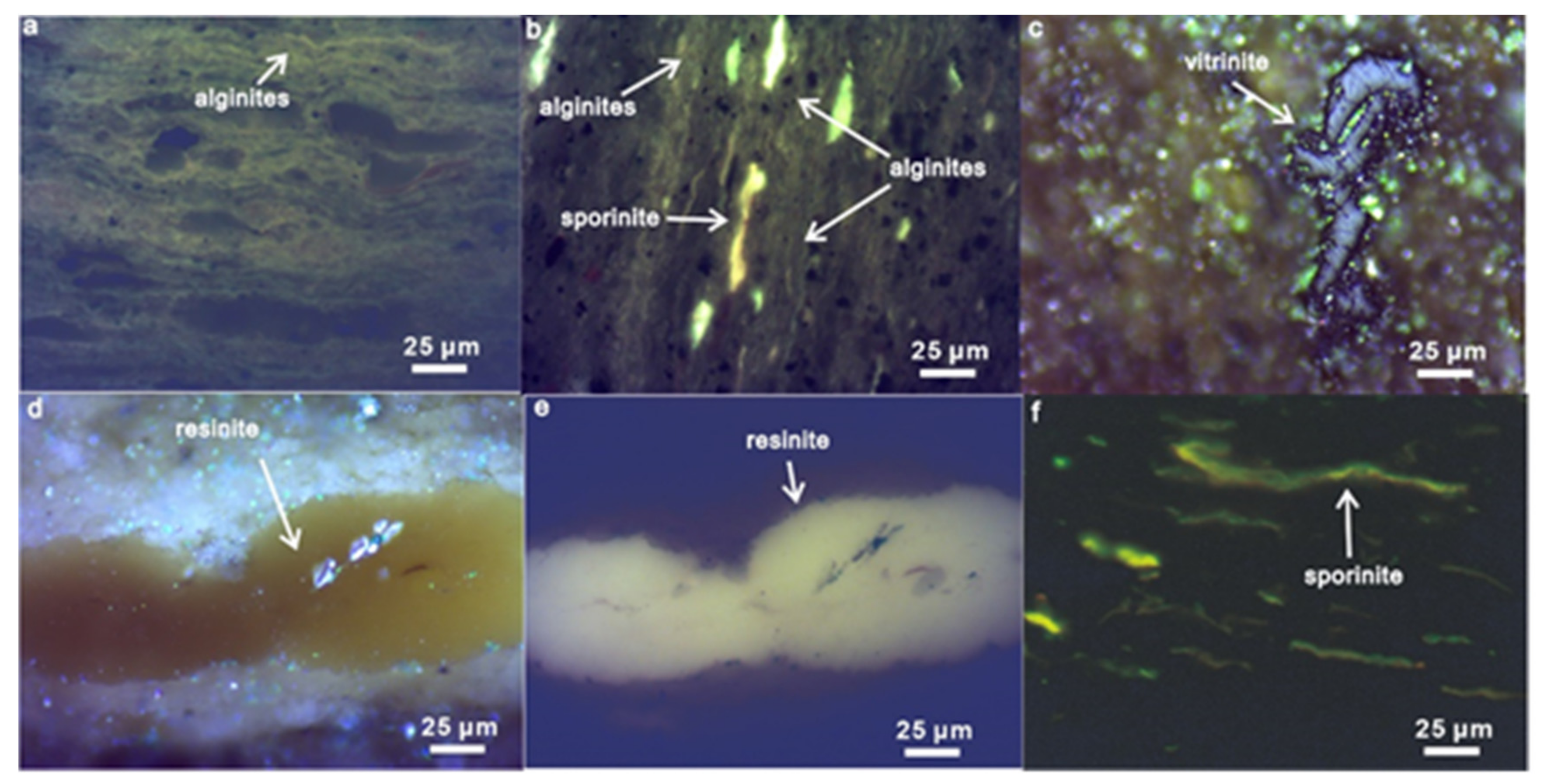

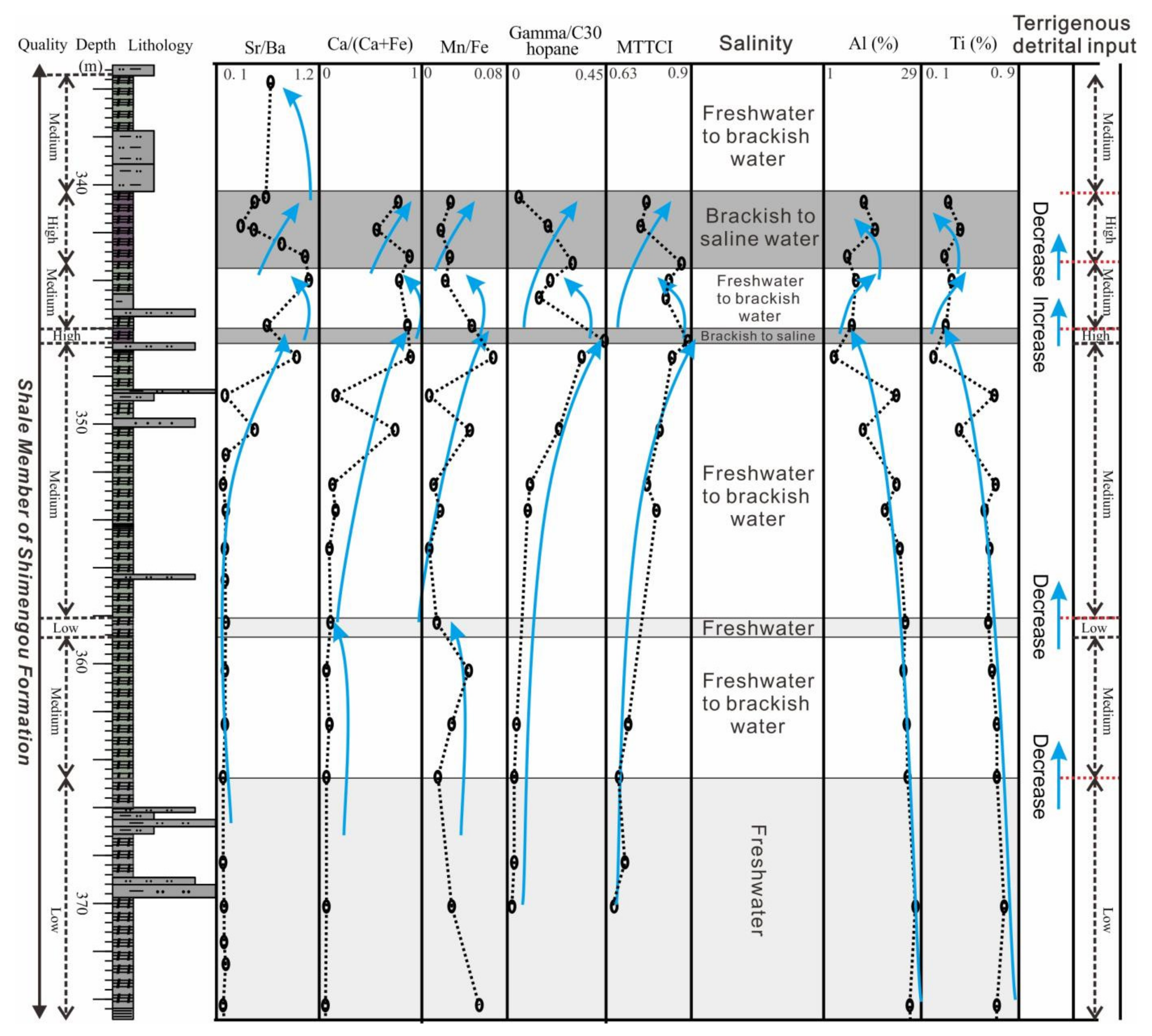
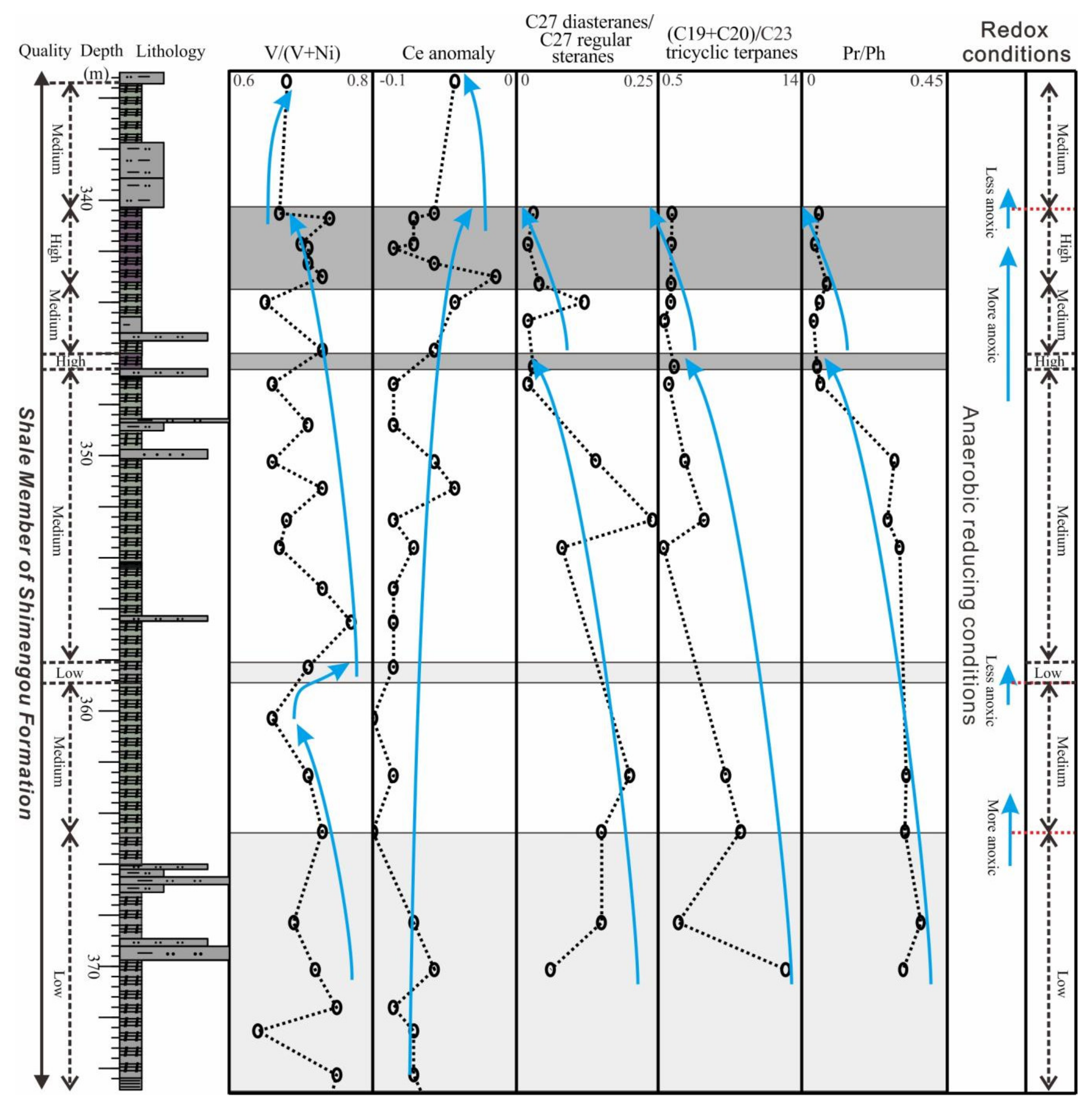
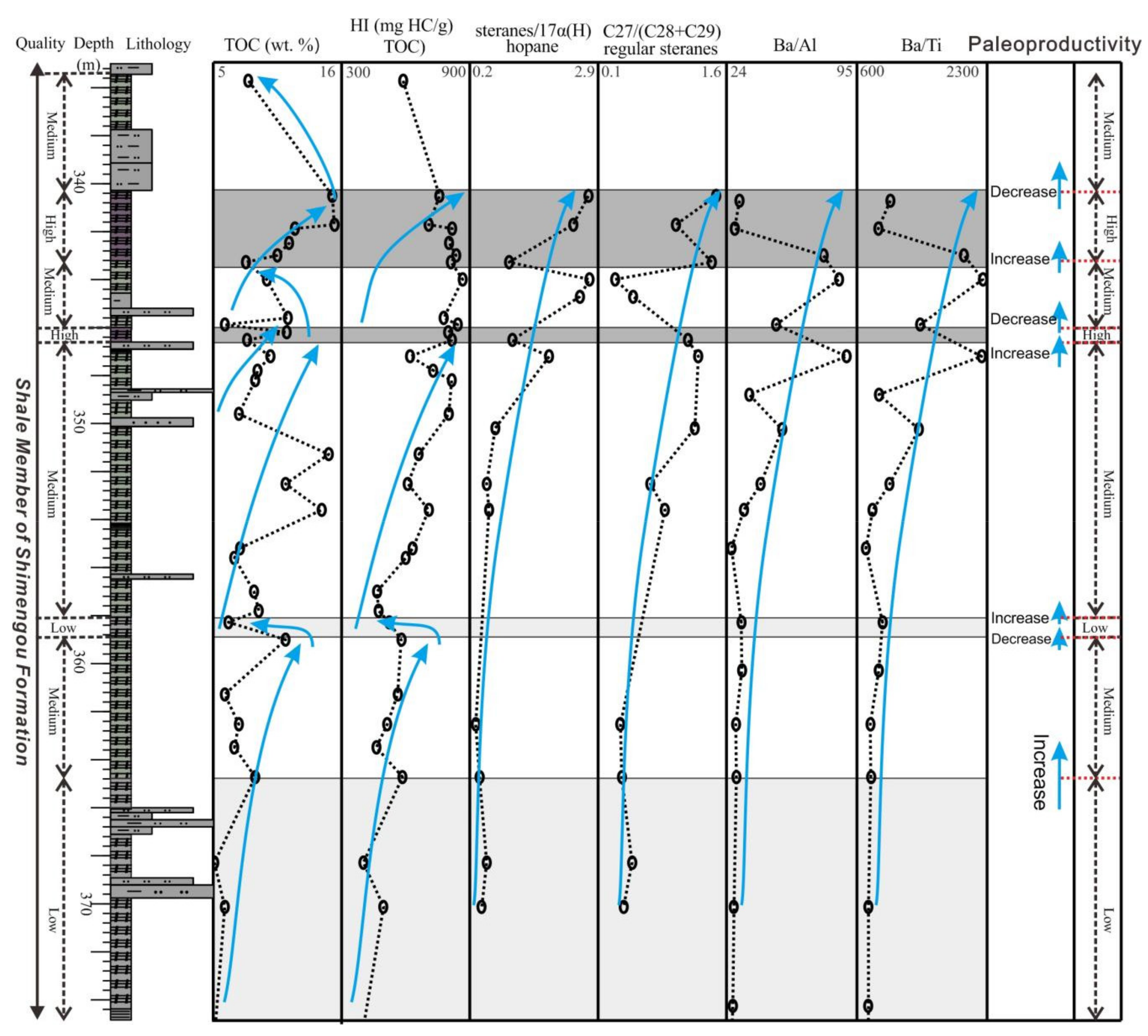
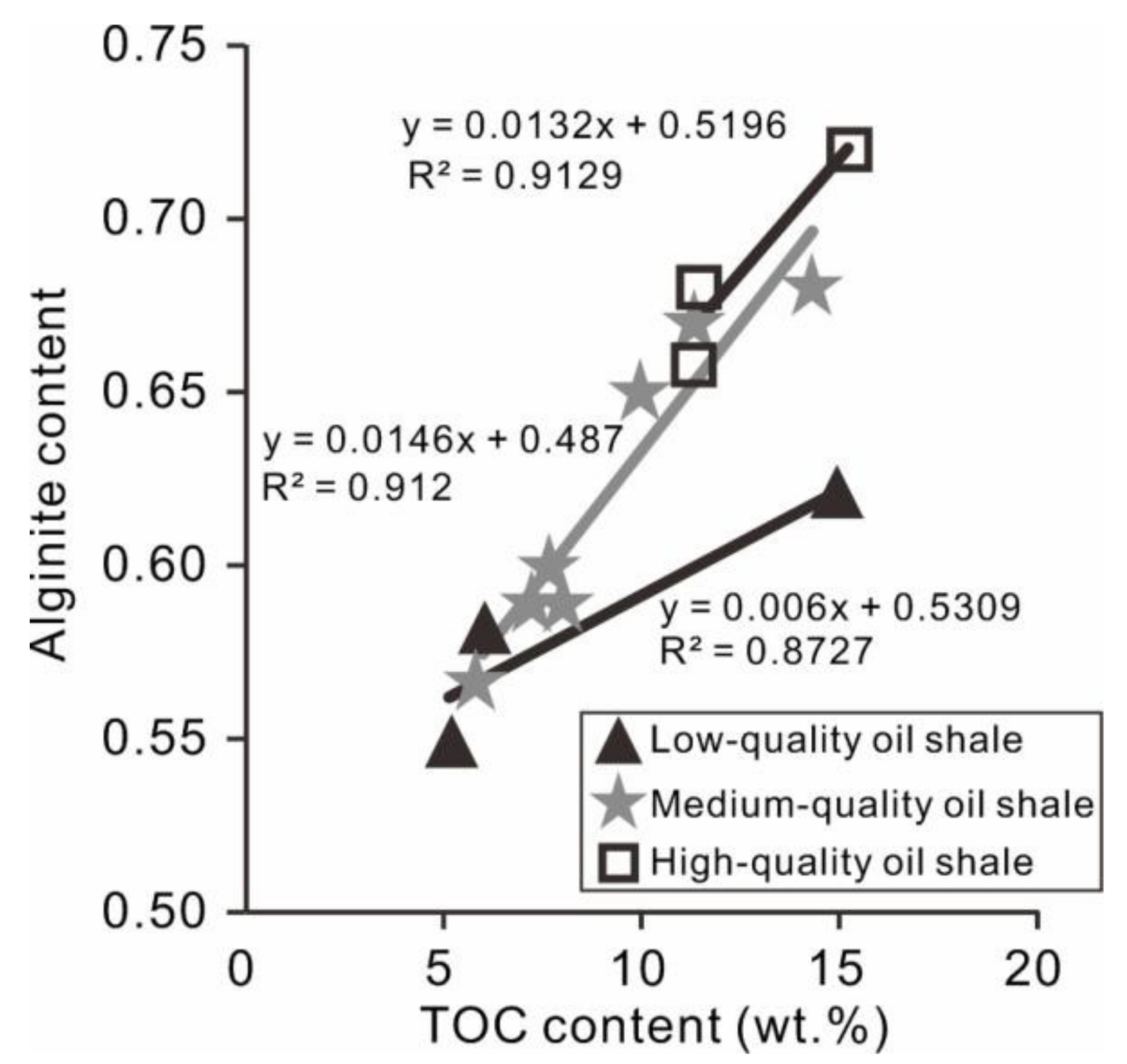
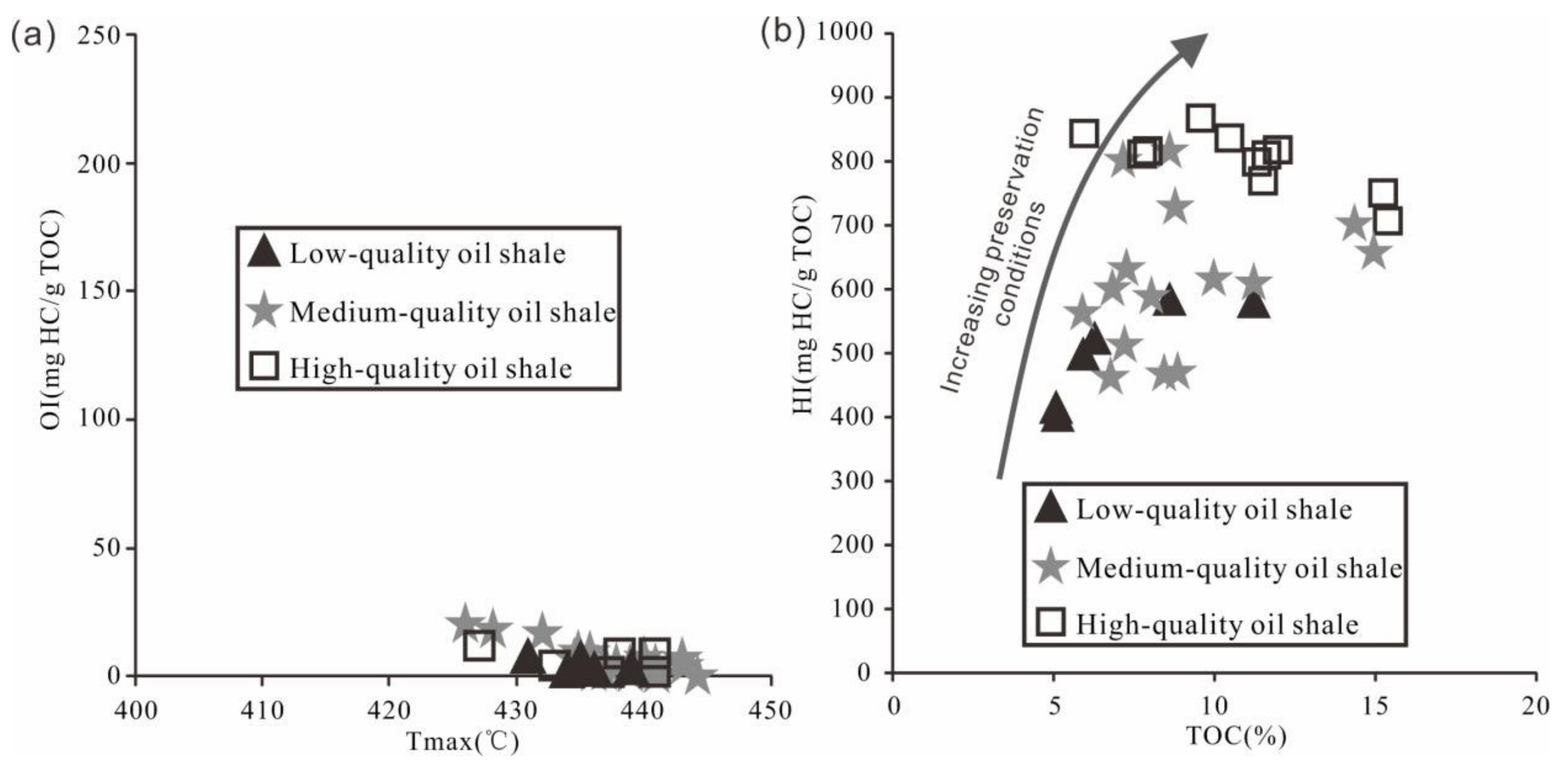
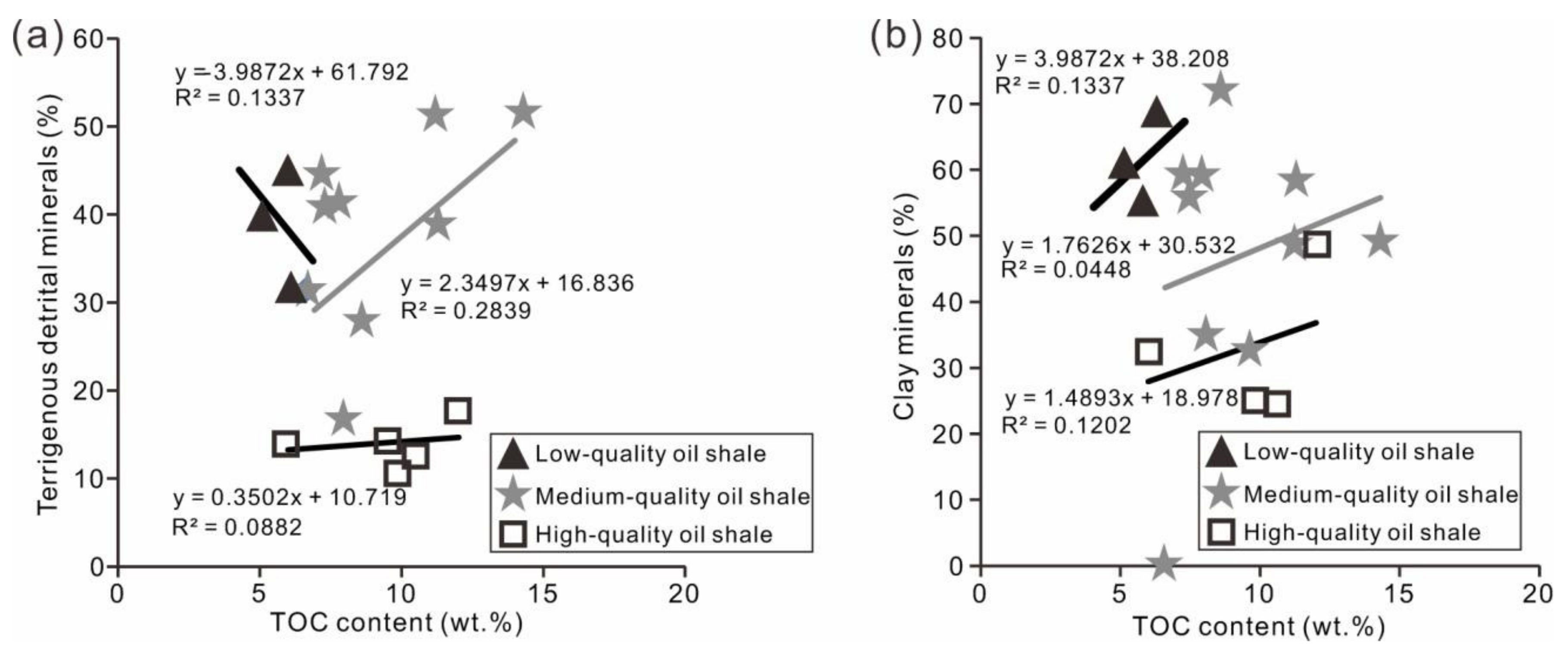
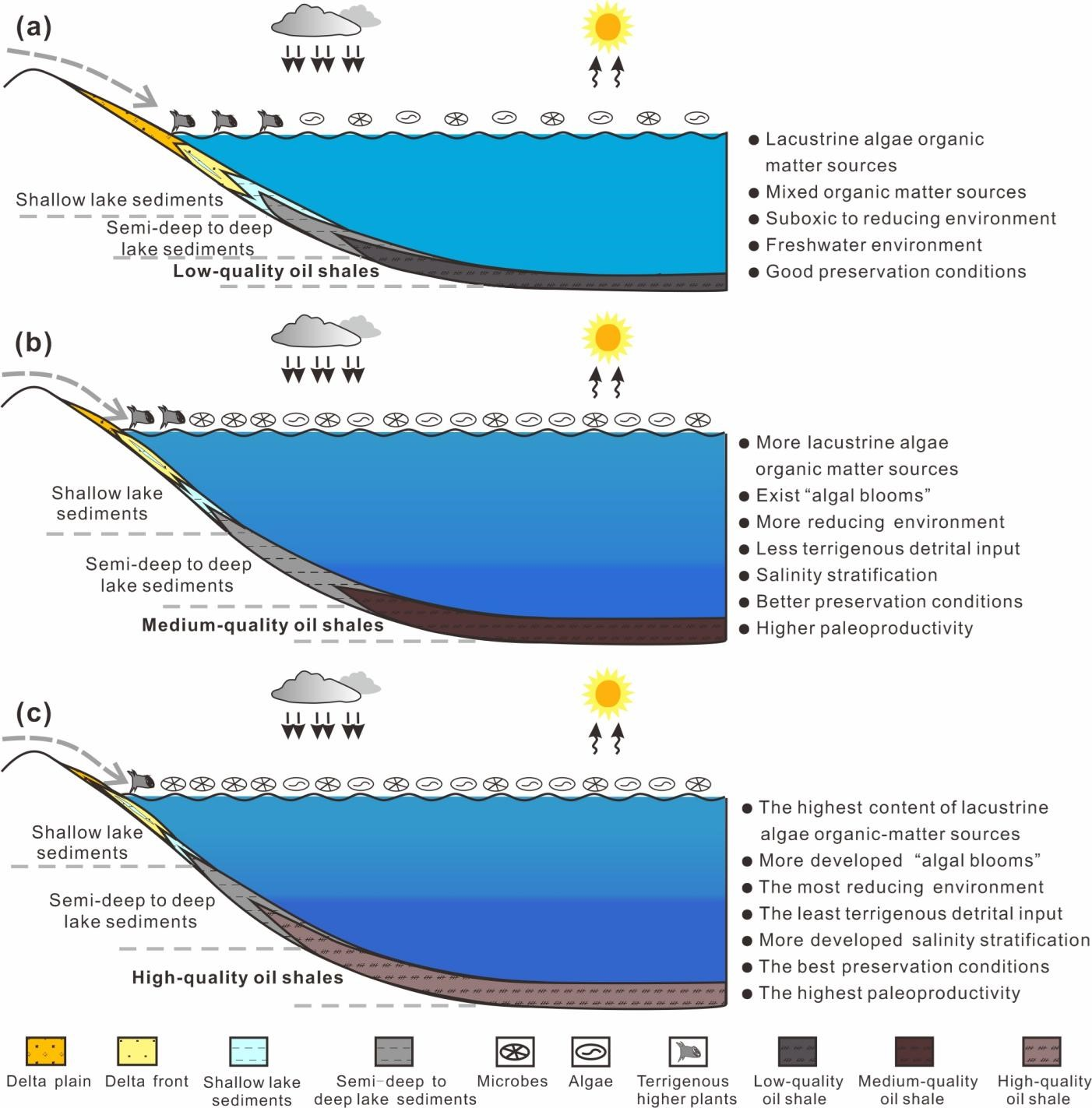
| Quality | Sample No. | Depth (m) | Oil Yield (wt.%) | Total Organic Carbon (TOC) (wt.%) | Ash Yield (wt.%) | Volatile Matter (wt.%) | Calorific Value (KJ/kg) |
|---|---|---|---|---|---|---|---|
| Low | PZ-01 | 367–368 | 3.8 | 5 | 76 | 23 | 2917 |
| PZ-02 | 370–371 | 4.2 | 6.4 | 68 | 30 | 3654 | |
| PZ-03 | 365–366 | 4.2 | 7.8 | 73 | 26 | 3663 | |
| PZ-04 | 358–359 | 4.4 | 6.4 | 84 | 13 | 2392 | |
| PZ-05 | 371–372 | 4.7 | 8.9 | 81 | 16 | 3560 | |
| Medium | PZ-06 | 356–357 | 5.7 | 6.1 | 74 | 24 | 3543 |
| PZ-07 | 357–358 | 7.1 | 11.3 | 70 | 31 | 5599 | |
| PZ-08 | 361–362 | 7.7 | 10.5 | 62 | 37 | 4961 | |
| PZ-09 | 353–354 | 8 | 13.7 | 77 | 21 | 6165 | |
| PZ-10 | 345–346 | 8.2 | 11.5 | 68 | 29 | 5358 | |
| PZ-11 | 360–361 | 8.5 | 11.5 | 63 | 39 | 5609 | |
| PZ-12 | 343–344 | 9.2 | 10.7 | 63 | 35 | 4689 | |
| High | PZ-13 | 341–342 | 10.2 | 15.5 | 71 | 28 | 7308 |
| PZ-14 | 346–347 | 11.0 | 16.8 | 74 | 11 | 6302 | |
| PZ-15 | 342–343 | 10.7 | 14.6 | 72 | 10 | 5897 |
| Quality | Depth (m) | TOC (wt.%) | Relative Content of Minerals (%) | ||||||||
|---|---|---|---|---|---|---|---|---|---|---|---|
| Terrigenous Detrital Minerals | Carbonate Minerals | CM | |||||||||
| Qtz | Pl | Total | Cal | Dol | Arg | Sd | Total | ||||
| Low | 370.1 | 6.0 | 44.9 | 44.9 | 55.1 | ||||||
| 368.3 | 5.1 | 39.7 | 39.7 | 60.3 | |||||||
| 358.3 | 6.3 | 31.4 | 31.4 | 68.6 | |||||||
| Medium | 364.7 | 8.6 | 27.9 | 27.9 | 72.1 | ||||||
| 362.5 | 7.2 | 41.3 | 41.3 | 58.7 | |||||||
| 360.3 | 11.3 | 38.9 | 38.9 | 3.4 | 3.4 | 57.7 | |||||
| 355.2 | 7.3 | 38.8 | 5.6 | 44.4 | 55.6 | ||||||
| 353.6 | 14.3 | 43.1 | 8.5 | 51.6 | 48.4 | ||||||
| 352.5 | 11.2 | 45.0 | 6.3 | 51.3 | 48.7 | ||||||
| 350.2 | 6.6 | 31.3 | 31.3 | 32.8 | 32.8 | 35.9 | |||||
| 348.8 | 7.8 | 41.4 | 41.4 | 58.6 | |||||||
| 335.7 | 8.0 | 16.8 | 16.8 | 37.5 | 10.8 | 48.3 | 34.9 | ||||
| High | 347.2 | 9.9 | 11.1 | 11.1 | 39.0 | 15.9 | 8.3 | 63.2 | 25.7 | ||
| 344.0 | 9.6 | 13.7 | 13.7 | 2.1 | 51.6 | 53.7 | 32.6 | ||||
| 345.9 | 6.0 | 14.4 | 14.4 | 52.6 | 52.6 | 33.0 | |||||
| 343.0 | 10.5 | 13.0 | 13.0 | 18.8 | 14.9 | 27.8 | 61.5 | 25.5 | |||
| 341.9 | 12.0 | 18.2 | 18.2 | 19.2 | 13.7 | 32.9 | 48.9 | ||||
| Oil Shale Quality | Low | Medium | High | |||
|---|---|---|---|---|---|---|
| Min.–Max. | Average | Min.–Max. | Average | Min.–Max. | Average | |
| TOC (wt.%) | 5.1–11.2 | 7.1 | 6.0–14.9 | 9.0 | 6.0–15.4 | 10.8 |
| S1 (mg HC/g rock) | 0.2–0.5 | 0.3 | 0.1–3.0 | 0.9 | 0.8–3.6 | 2.4 |
| S2 (mg HC/g rock) | 20.2–64.9 | 36.4 | 31.5–101.2 | 55.9 | 50.3–115.1 | 85.4 |
| S1 + S2 (mg HC/g rock) | 20.5–65.4 | 36.7 | 31.8–102 | 56.8 | 51.8–118.6 | 87.8 |
| PI | 0.01 | 0.01 | 0–0.04 | 0.02 | 0.01–0.04 | 0.03 |
| Tmax (°C) | 431–439 | 437 | 426–444 | 436 | 427–441 | 437 |
| %Ro/ Tmax (°C) | 0.61 ± 0.06/431 and 0.69 ± 0.07/435 | 0.65 | 0.61 ± 0.08/432 and 0.59 ± 0.07/426 | 0.60 | 0.69 ± 0.08/441 and 0.61 ± 0.08/427 | 0.65 |
| HI (mg HC/g TOC) | 392–584 | 496 | 463–815 | 616 | 707–866 | 803 |
| OI (mg HC/g TOC) | 3–7 | 4 | 1–21 | 7 | 4–13 | 7 |
| Sr/Ba | 0.17–0.20 | 0.18 | 0.17–0.96 | 0.34 | 0.36–1.09 | 0.71 |
| Ca/(Ca + Fe) | 0.06–0.11 | 0.08 | 0.05–0.89 | 0.23 | 0.56–0.88 | 0.77 |
| V/(V + Ni) | 0.64–0.75 | 0.71 | 0.66–0.77 | 0.70 | 0.65–0.74 | 0.71 |
| Ce anomaly | −0.06 to −0.04 | −0.05 | −0.07 to −0.03 | −0.05 | −0.05 to −0.01 | −0.04 |
| Ba/Ti | 747–937 | 805 | 667–2230 | 986 | 881–2246 | 1517 |
| Ba/Al | 27–32 | 29 | 25–89 | 38 | 28–85 | 55 |
| Ti (%) | 0.65–0.78 | 0.72 | 0.2–0.78 | 0.63 | 0.29–0.42 | 0.34 |
| Al (%) | 18.89–20.88 | 19.72 | 4.99–20.41 | 16.40 | 7.58–12.99 | 9.83 |
| Quality | Depth (m) | TOC (wt.%) | C15–C19 n-Alkanes (%) | C21–C25 n-Alkanes (%) | C27–C31 n-Alkanes (%) | CPI | Pr/Ph | C27 Regular Sterane /(C27 + C28 + C29) Regular Steranes (%) | C28 Regular Sterane /(C27 + C28 + C29) Regular Steranes (%) | C29 Regular Sterane /(C27 + C28 + C29) Regular Steranes (%) |
|---|---|---|---|---|---|---|---|---|---|---|
| Low | 364.7 | 8.6 | 0.28 | 0.49 | 0.14 | 1.77 | 2.84 | 29.21 | 21 | 49.79 |
| Low | 368.3 | 5.1 | 0.28 | 0.5 | 0.13 | 1.83 | 3.27 | 36.09 | 13.57 | 50.34 |
| Low | 370.1 | 6 | 0.3 | 0.45 | 0.16 | 1.85 | 2.79 | 31.14 | 14.9 | 53.96 |
| Average | 6.6 | 0.29 | 0.48 | 0.14 | 1.82 | 2.97 | 32.15 | 16.49 | 51.36 | |
| Medium | 344 | 9.6 | 0.22 | 0.62 | 0.11 | 2.01 | 0.49 | 73.1 | 11.64 | 15.26 |
| Medium | 347.2 | 9.9 | 0.17 | 0.33 | 0.47 | 1.43 | 0.51 | 65.14 | 10.75 | 24.11 |
| Medium | 350.2 | 6.6 | 0.24 | 0.44 | 0.22 | 2.56 | 2.55 | 42.59 | 16.91 | 40.49 |
| Medium | 352.5 | 11.2 | 0.26 | 0.55 | 0.13 | 2.13 | 2.36 | 35.72 | 19.84 | 44.45 |
| Medium | 353.6 | 14.3 | 0.23 | 0.41 | 0.27 | 2.09 | 2.69 | 37.88 | 17.23 | 44.89 |
| Medium | 362.5 | 7.2 | 0.28 | 0.53 | 0.11 | 2.05 | 2.87 | 24.68 | 24.57 | 50.76 |
| Average | 9.8 | 0.23 | 0.48 | 0.22 | 2.05 | 1.91 | 46.52 | 16.82 | 36.66 | |
| High | 340.5 | 15.2 | 0.27 | 0.55 | 0.13 | 1.84 | 0.47 | 72.94 | 9.91 | 17.15 |
| High | 341.7 | 15.4 | 0.18 | 0.54 | 0.26 | 1.74 | 0.36 | 70.44 | 13.44 | 16.13 |
| High | 343.3 | 7.8 | 0.12 | 0.6 | 0.25 | 1.92 | 0.69 | 50.73 | 22.17 | 27.1 |
| High | 344.7 | 5.8 | 0.33 | 0.44 | 0.16 | 2.08 | 0.33 | 71.58 | 12.17 | 16.25 |
| High | 346.5 | 7.9 | 0.21 | 0.26 | 0.44 | 2.08 | 0.42 | 52.39 | 11.3 | 36.32 |
| Average | 10.42 | 0.22 | 0.48 | 0.25 | 1.93 | 0.45 | 63.62 | 13.8 | 22.59 | |
| Quality | Depth (m) | TOC (wt.%) | Ts/ (Ts + Tm) | C27 regular steranes/ (C28 + C29) regular steranes | C29 αββ 20S/(20S + 20R) steranes | C27 diasteranes/C27 steranes | Regular steranes/C30 αβ hopane | Gammacerane/C30 αβ hopane | C19 + C20 tricyclic terpanes/C23 tricyclic terpane | |
| Low | 364.7 | 8.6 | 0.06 | 0.41 | 0.16 | 0.15 | 0.38 | 0.03 | 8.27 | |
| Low | 368.3 | 5.1 | 0.05 | 0.56 | 0.18 | 0.15 | 0.5 | 0.03 | 2.4 | |
| Low | 370.1 | 6 | 0.05 | 0.45 | 0.18 | 0.06 | 0.4 | 0.02 | 12.49 | |
| Average | 6.6 | 0.05 | 0.47 | 0.17 | 0.12 | 0.43 | 0.03 | 7.72 | ||
| Medium | 344 | 9.6 | 0.09 | 2.72 | 0.14 | 0.12 | 0.3 | 0.19 | 1.69 | |
| Medium | 347.2 | 9.9 | 0.06 | 1.87 | 0.4 | 0.02 | 1.27 | 0.33 | 1.5 | |
| Medium | 350.2 | 6.6 | 0.21 | 0.74 | 0.13 | 0.14 | 1.23 | 0.23 | 3.01 | |
| Medium | 352.5 | 11.2 | 0.1 | 0.56 | 0.17 | 0.24 | 0.71 | 0.1 | 4.83 | |
| Medium | 353.6 | 14.3 | 0.21 | 0.61 | 0.1 | 0.08 | 0.88 | 0.09 | 1.01 | |
| Medium | 362.5 | 7.2 | 0.06 | 0.33 | 0.16 | 0.2 | 0.36 | 0.04 | 6.86 | |
| Average | 9.8 | 0.12 | 1.14 | 0.18 | 0.13 | 0.79 | 0.16 | 3.15 | ||
| High | 340.5 | 15.2 | 0.07 | 2.7 | 0.1 | 0.03 | 1.48 | 0.05 | 1.8 | |
| High | 341.7 | 15.4 | 0.1 | 2.38 | 0.03 | 0.02 | 1.01 | 0.18 | 1.74 | |
| High | 343.3 | 7.8 | 0.09 | 1.03 | 0.07 | 0.04 | 1.43 | 0.29 | 1.73 | |
| High | 344.7 | 5.8 | 0.08 | 2.52 | 0.04 | 0.02 | 0.51 | 0.14 | 1.09 | |
| High | 346.5 | 7.9 | 0.06 | 1.1 | 0.05 | 0.03 | 1.15 | 0.43 | 2.02 | |
| Average | 10.42 | 0.08 | 1.95 | 0.06 | 0.03 | 1.12 | 0.22 | 1.68 | ||
| Quality | Depth (m) | TOC (wt.%) | Lacustrine Aquatic Organism Sources | Terrigenous Higher Plants | ||||||
|---|---|---|---|---|---|---|---|---|---|---|
| Alginite | Liptinite | Vitrinite | Chlorophyllinite | Total | ||||||
| Sporinite | Resinite | Fluorinite | Total | |||||||
| Low | 370.1 | 5.96 | 0.58 | 0.19 | 0.04 | 0.03 | 0.26 | 0.08 | 0.34 | |
| 368.3 | 5.13 | 0.55 | 0.29 | 0.02 | 0.31 | 0.09 | 0.01 | 0.41 | ||
| 370.23 | 14.92 | 0.62 | 0.18 | 0.03 | 0.21 | 0.12 | 0.33 | |||
| Average | 0.58 | 0.22 | 0.04 | 0.03 | 0.26 | 0.1 | 0.01 | 0.36 | ||
| Medium | 362.5 | 7.23 | 0.59 | 0.26 | 0.03 | 0.29 | 0.1 | 0.39 | ||
| 361.3 | 5.97 | 0.57 | 0.26 | 0.09 | 0.35 | 0.05 | 0.01 | 0.41 | ||
| 359.8 | 7.64 | 0.6 | 0.29 | 0.02 | 0.31 | 0.05 | 0.01 | 0.37 | ||
| 356.5 | - | 0.57 | 0.34 | 0.02 | 0.36 | 0.06 | 0.42 | |||
| 353.6 | 14.3 | 0.68 | 0.18 | 0.05 | 0.03 | 0.26 | 0.03 | 0.29 | ||
| 348.8 | 7.84 | 0.59 | 0.1 | 0.13 | 0.02 | 0.25 | 0.11 | 0.36 | ||
| 347.2 | 9.94 | 0.65 | 0.23 | 0.23 | 0.1 | 0.33 | ||||
| 346.6 | 11.34 | 0.67 | 0.28 | 0.28 | 0.02 | 0.3 | ||||
| Average | 0.62 | 0.24 | 0.09 | 0.04 | 0.29 | 0.07 | 0.01 | 0.36 | ||
| High | 346.2 | 11.3 | 0.66 | 0.24 | 0.03 | 0.27 | 0.03 | 0.3 | ||
| 342.48 | 11.45 | 0.68 | 0.25 | 0.03 | 0.28 | 0.02 | 0.01 | 0.31 | ||
| 341.5 | 15.2 | 0.72 | 0.19 | 0.03 | 0.22 | 0.03 | 0.25 | |||
| Average | 0.69 | 0.23 | 0.03 | 0.03 | 0.26 | 0.03 | 0.01 | 0.29 | ||
Publisher’s Note: MDPI stays neutral with regard to jurisdictional claims in published maps and institutional affiliations. |
© 2022 by the authors. Licensee MDPI, Basel, Switzerland. This article is an open access article distributed under the terms and conditions of the Creative Commons Attribution (CC BY) license (https://creativecommons.org/licenses/by/4.0/).
Share and Cite
Bai, Y.; Liu, Z.; George, S.C.; Meng, J. A Comparative Study of Different Quality Oil Shales Developed in the Middle Jurassic Shimengou Formation, Yuqia Area, Northern Qaidam Basin, China. Energies 2022, 15, 1231. https://doi.org/10.3390/en15031231
Bai Y, Liu Z, George SC, Meng J. A Comparative Study of Different Quality Oil Shales Developed in the Middle Jurassic Shimengou Formation, Yuqia Area, Northern Qaidam Basin, China. Energies. 2022; 15(3):1231. https://doi.org/10.3390/en15031231
Chicago/Turabian StyleBai, Yueyue, Zhaojun Liu, Simon C. George, and Jingyao Meng. 2022. "A Comparative Study of Different Quality Oil Shales Developed in the Middle Jurassic Shimengou Formation, Yuqia Area, Northern Qaidam Basin, China" Energies 15, no. 3: 1231. https://doi.org/10.3390/en15031231
APA StyleBai, Y., Liu, Z., George, S. C., & Meng, J. (2022). A Comparative Study of Different Quality Oil Shales Developed in the Middle Jurassic Shimengou Formation, Yuqia Area, Northern Qaidam Basin, China. Energies, 15(3), 1231. https://doi.org/10.3390/en15031231







